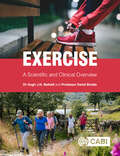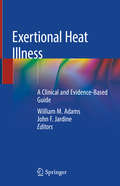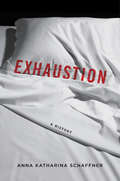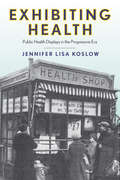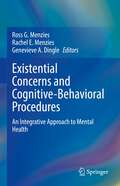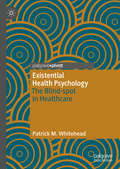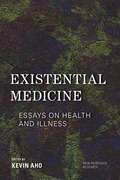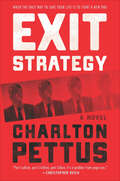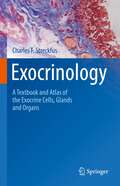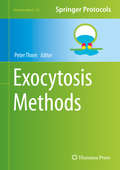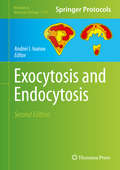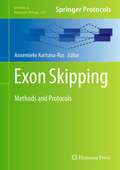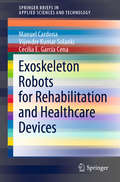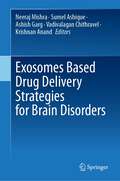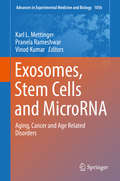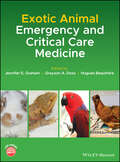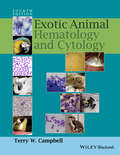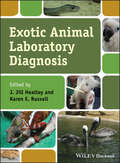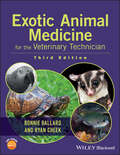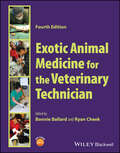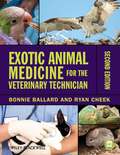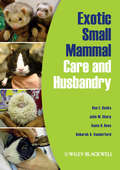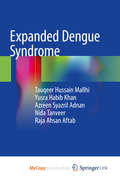- Table View
- List View
Exercise: A Scientific and Clinical Overview
by Dr Hugh J. Bethell Professor David BrodieThis book is about exercise - what it is, how it affects the individual, how it is measured and most of all what benefits it brings. Beginning with an introduction to the history and biology of exercise, the authors review the interactions between exercise and specific diseases, such as diabetes, coronary heart disease, cancer and many more, before considering exercise in a wider health context. The book covers: - Current societal norms, as well as the social and economic costs of inactivity. - Exercise for life - from starting young, to pregnancy, longevity and frailty. - Complications of exercise. - The intersections of behavioural psychology and exercise, such as encouragement and excuse making. With comprehensive and clear explanations based on sound science, yet written in an approachable and accessible style, this book is a valuable resource for students of medicine, public health, physiotherapy, sports science, coaching and training.
Exertional Heat Illness: A Clinical and Evidence-Based Guide
by William M. Adams John F. JardineThis authoritative work provides clinicians, scientists and students with a comprehensive overview of exertional heat illness. Specifically, it addresses the prevention, recognition, treatment, and care of the various medical conditions that fall within the realm of exertional heat illness. In doing so, the book also offers a setting-specific (that is, athletics, military, occupational, and road race medicine) discussion of exertional heat illness for the consideration of the varied medical providers working in these settings. Clinicians will benefit from the discussion of the evidence-based best-practice considerations that should be made in the management of exertional heat illness. Scientists will benefit from this text in that it will provide them with a review of the current scientific evidence related to exertional heat illness and the translation of evidence to clinical practice – while also discussing directions for future research. Finally, students -- primarily postgraduate students interested in developing a line of research related to exertional heat illness -- will find this title an indispensable text to familiarize themselves with this fascinating field of study. A major contribution to the literature, Exertional Heat Illness: A Clinical and Evidence-Based Guide will be of significant interest to clinicians and scientists at all levels of training and experience, especially professionals in athletic training, emergency medical services, emergency room care, sports medicine and primary care.
Exhaustion: A History
by Anna K. SchaffnerToday our fatigue feels chronic; our anxieties, amplified. Proliferating technologies command our attention. Many people complain of burnout, and economic instability and the threat of ecological catastrophe fill us with dread. We look to the past, imagining life to have once been simpler and slower, but extreme mental and physical stress is not a modern syndrome. Beginning in classical antiquity, this book demonstrates how exhaustion has always been with us and helps us evaluate more critically the narratives we tell ourselves about the phenomenon.Medical, cultural, literary, and biographical sources have cast exhaustion as a biochemical imbalance, a somatic ailment, a viral disease, and a spiritual failing. It has been linked to loss, the alignment of the planets, a perverse desire for death, and social and economic disruption. Pathologized, demonized, sexualized, and even weaponized, exhaustion unites the mind with the body and society in such a way that we attach larger questions of agency, willpower, and well-being to its symptoms. Mapping these political, ideological, and creative currents across centuries of human development, Exhaustion finds in our struggle to overcome weariness a more significant effort to master ourselves.
Exhibiting Health: Public Health Displays in the Progressive Era (Critical Issues in Health and Medicine)
by Jennifer Lisa KoslowIn the early twentieth century, public health reformers approached the task of ameliorating unsanitary conditions and preventing epidemic diseases with optimism. Using exhibits, they believed they could make systemic issues visual to masses of people. Embedded within these visual displays were messages about individual action. In some cases, this meant changing hygienic practices. In other situations, this meant taking up action to inform public policy. Reformers and officials hoped that exhibits would energize America's populace to invest in protecting the public's health. Exhibiting Health is an analysis of the logic of the production and the consumption of this technique for popular public health education between 1900 and 1930. It examines the power and limits of using visual displays to support public health initiatives.
Existential Concerns and Cognitive-Behavioral Procedures: An Integrative Approach to Mental Health
by Ross G. Menzies Rachel E. Menzies Genevieve A. DingleClients enter therapy grappling with a range of difficulties. They don’t speak in diagnostic terms, but instead focus on the everyday problems that confront them. Their struggles may include isolation, loneliness, anxiety, guilt and regret, and problems making decisions in a world that offers seemingly endless choice. In contrast, the cognitive-behavior therapist is trained in the language of conditioning and extinction, avoidance and safety behaviors, behavioral activation and attentional biases. This book explores the ideas of the existentialist philosophers as a bridge between the suffering client and technically trained clinician. The volume is not a rejection of cognitive behavior therapy (CBT), but seeks to place CBT in the broader context of the most popular philosophic tradition of the 19th and 20th centuries. Therapists versed in existentialism argue that the individual's starting point is characterized by a sense of disorientation in the face of an apparently meaningless and absurd world. Each individual must become solely responsible for giving meaning to life and living it passionately and authentically. Each of us must confront the ‘Big 5’ existential issues of death, isolation, identity, freedom and meaning and find our solutions to these problems. The present volume explores each of these existential themes in turn. Each section opens with a theoretical chapter describing the relevant existential dilemma and its impact on human experience. The second chapter in each section explores its relationship to mental health disorders and psychopathology. The third chapter in each section explores the evidence for treating the existential issue from a CBT framework. This book will be of value to those interested in CBT, philosophy and mental health, and will appeal to psychotherapists, clinical psychologists and psychiatrists.
Existential Health Psychology: The Blind-spot in Healthcare
by Patrick M. WhiteheadThis volume critiques the increasingly reductive, objectifying, and technologized orientation in mainstream biomedicine. Drawing on the methods of hermeneutic phenomenology and existential analysis in the work of Martin Heidegger, Kurt Goldstein, Medard Boss, and Hans-Georg Gadamer, the author seeks to expose this lacuna and explore the ways in which it misrepresents (or misunderstands) the human condition. Whitehead begins by examining the core distinction in the sociology of medicine between “disease” and “illness” and how this distinction maps onto a more fundamental distinction between the corporeal/objective body and the experiential/lived body. Ultimately, the book exposes the tendency in modern medicine to medicalize the human condition and forwards a reorientation framed by what the author terms “existential health psychology.”
Existential Medicine: Essays on Health and Illness
by Kevin AhoThis book offers cutting edge research on the modifications and disruptions of bodily experience in the context of anxiety, depression, trauma, chronic illness, pain, and aging. It presents original contributions in applied phenomenology, biomedical ethics, and the use of medical technologies.
Exit Strategy: A Novel
by Charlton PettusIn this debut thriller, a desperate scientist uses a secret organization to a start new life, but one mistake can end it all.Sometimes you just need to escape. For crooked politicians, military brass from third-world nations, and white-collar criminals looking to avoid either prison or a deadlier form of payback, there’s Exit Strategy. With just one call, Exit Strategy helps these wealthy-but-wanted types disappear completely. They can fake your death, give you a new name and face, and launder whatever ill-gotten funds you need to establish a new life on the other side of the world.When Jordan Parrish, the brilliant founder of a medical technology start-up, made the call, he thought he had no other way out. With his marriage in shambles and his company on the brink of financial ruin, it seemed the only way to make things right. But after his exit, he began to wonder about the circumstances that led him to make that momentous decision: was someone, in fact, working against him? To find out, Jordan will have to break the cardinal rule of Exit Strategy: you can never, ever go back.Charlton Pettus’s Exit Strategy is a cutting-edge, globe-trotting thriller about the type of shadowy organization that most of us have long suspected exists behind the scenes.Praise for Exit Strategy“Part Ludlum, part Crichton, part Coben, it’s a grabber from page one.” —Christopher Reich, New York Times–bestselling author of Rules of Deception“Haven’t we all, at one time or another, wanted to escape into a brand-new, unencumbered existence? . . . Pettus captures the excitement of waking up in a strange country with a lot of money in your pocket.” —New York Times Book Review“[A] terrific first novel. . . . Cerebral and visceral, this is a top-notch thriller.” —Publishers Weekly (starred review)
Exocrinology: A Textbook and Atlas of the Exocrine Cells, Glands and Organs
by Charles F. StreckfusThis is the first textbook solely dedicated to the study of exocrine glands and cells throughout the human body. Students will gain a broad overview of the whole exocrine system, it’s structural features and learn to understand it’s integral parts in almost all bodily functions. Taking a systemic approach, the author guides readers through the different organ sites, shapes, methods of secretion and their secretory products. Starting with the glands of the integument, which is covering the outside of the body, the chapters proceed to also discuss the urinary tract, respiratory, digestive and reproductive systems. Various levels of complexity, from single goblet cells to the major organs, are thoroughly explained. A basic knowledge in histology is advantageous, for the numerous and rich illustrations. With its inviting writing style, this textbook is a perfect learning tool for students in Physiology and Medicine – particularly considering Dentistry, Dermatology, Gastroenterology and Pulmonology.
Exocytosis Methods
by Peter ThornBringing together techniques and methods currently being applied to the study of exocytosis, "Exocytosis Methods" collects chapters from experts in the field, examining this fundamental process essential to functions ranging from protein secretion to hormone release and neurotransmission. The book begins with a section covering a range of techniques being applied to the study of single-vesicle fusion events, which are key in order to gain insight into the final steps of vesicle fusion. The volume continues with several model systems that are being employed to unravel the complexities of exocytosis. Written for the "Neuromethods" series, chapters included in this work present the kind of detail and vital implementation advice that leads to successful results. Practical and authoritative, "Exocytosis Methods" seeks to promote the advent of new methods in microscopy and the development of new preparations, which would doubtlessly lead to many new and exciting discoveries in this field. "
Exocytosis and Endocytosis
by Andrei I. IvanovIn this book, skilled experts provide the most up-to-date, step-by-step laboratory protocols for examining molecular machinery and biological functions of exocytosis and endocytosis in vitro and in vivo. The book is insightful to both newcomers and seasoned professionals. It offers a unique and highly practical guide to versatile laboratory tools developed to study various aspects of intracellular vesicle trafficking in simple model systems and living organisms.
Exogenous Enzymes as Feed Additives in Ruminants
by Abdelfattah Zeidan Mohamed Salem Abubeker Hassen Uchenna Y. AneleThis book addresses a global issue of increasing high quality food from ruminant animals while reducing their impacts on the environment. However, one of the main constraints to livestock development and the underlying cause of the low productivity in many developing countries is inadequate nutrition associated with inefficient utilization of forages and fibrous feed resources. In many countries, fibrous feed makes up the bulk of available feed resource base, which is characterized by scarcity and fluctuating supply in the quantity and quality of feed resources, nutrient imbalance as seen in many native pastures, grasslands and crop residues-based feeding systems with limited use of commercial concentrate feeds such as soybean, cottonseed and groundnut meals, etc. Furthermore, the production of methane, an important greenhouse gas (GHG), from ruminants fed highly fibrous diets such as straws and stover is higher than those animals fed better quality forages or concentrate diets. Recent research shows that supplementing livestock diets with exogenous fibre degrading enzymes can improve feed utilization by enhancing intake, fibre degradation in the rumen and overall digestibility of fibrous feeds which in turn leads to improved animal performance, farmers’ income, and a reduction in GHG emissions. The book editors would like to acknowledge the Joint FAO/IAEA Division of Nuclear Techniques in Food and Agriculture for funding part of the studies that make up some of these chapters and were part of the final reports of a coordinated research project financed by IAEA.
Exon Skipping
by Annemieke Aartsma-Rus"Next generation" sequencing techniques allow for more detailed analysis of exons and introns in multiple genes at the same time. This will reveal many mutations that potentially lead to exon skipping. To functionally test these a lot can be achieved with a limited set of protocols, while for the intentional induction of exon skipping different tools and target genes are involved and the translational path from in vitro splicing to in vivo tests in animal models requiring a more extensive set of protocols. Exon Skipping: Methods and Protocols provides scientist with a comprehensive guide to many of the methods and techniques used for exon skipping, such as methods on how to discriminate "real polymorphisms" from mutations that affect splicing. Written in the highly successful Methods in Molecular BiologyTM series format, chapters include introductions to their respective topics, lists of the necessary materials and reagents, step-by-step, readily reproducible laboratory protocols, and key tips on troubleshooting and avoiding known pitfalls. Authoritative and practical Exon Skipping: Methods and Protocols seeks to aid scientists in the continuing study of exon skipping.
Exoskeleton Robots for Rehabilitation and Healthcare Devices (SpringerBriefs in Applied Sciences and Technology)
by Vijender Kumar Solanki Manuel Cardona Cecilia E. García CenaThis book addresses cutting-edge topics in robotics and related technologies for rehabilitation, covering basic concepts and providing the reader with the information they need to solve various practical problems. Intended as a reference guide to the application of robotics in rehabilitation, it covers e.g. musculoskeletal modelling, gait analysis, biomechanics, robotics modelling and simulation, sensors, wearable devices, and the Internet of Medical Things.
Exosomes Based Drug Delivery Strategies for Brain Disorders
by Krishnan Anand Neeraj Mishra Sumel Ashique Ashish Garg Vadivalagan ChithravelThis book provides a comprehensive overview of the role of exosomes in brain diseases, including stroke, multiple sclerosis, Parkinson's disease, Alzheimer's disease, epilepsy, and depression. It covers the basics of exosome biogenesis, composition, and synthesis, as well as the therapeutic potential of exosomes in brain disorders. The correlation between exosomes and neuroinflammation, the challenges of using exosomes as a novel carrier, and engineered exosomes to deliver therapeutic protein are covered well in this book. Use of radiolabelled exosomes as a diagnostic tool and the toxicity studies of exosomes with potential overcome approaches. It is an essential resource for researchers, clinicians, and healthcare professionals working in the field of exosome research, especially on its applications in brain disorders.
Exosomes, Stem Cells and MicroRNA: Aging, Cancer And Age Related Disorders (Advances In Experimental Medicine And Biology #1056)
by Vinod Kumar Pranela Rameshwar Karl L. MettingerThis volume provides insight into the pivotal roles of stem cells, exosomes and other microvesicles in biofunction and molecular mechanisms and their therapeutic potential in translational nanomedicine. It further highlights evidence from recent studies as to how stem cell derived exosomes and microRNAs may restore and maintain tissue homeostasis, enable cells to recover critical cellular functions and begin repair regeneration. These early studies in animal models of aging also show evidence of improved immune, cardiovascular and cognitive functions as well as improved health span and life span. The use of exosomes from body fluids to define specific biomarkers for various tumors may also clear the path to patient-targeted treatments by developing exosome-derived microRNA based cancer therapeutics. It is essential reading for graduate students, research fellow and biomedical researchers in academia or the pharmaceutical or biotech industries.
Exotic Animal Emergency and Critical Care Medicine
by Jennifer E. Graham Grayson A. Doss Hugues Beaufr ReExotic Animal Emergency and Critical Care Medicine delivers the most relevant and current information required by general veterinary practitioners and veterinary specialists in treating emergent and critical exotic patients. Covering the management of common emergency presentations in exotic companion mammals, birds, reptiles, and amphibians, each section discusses triage and stabilization, diagnostics, nutrition and fluid therapy, analgesia, anesthesia, monitoring, CPR, and euthanasia. The book includes quick reference tables, species-specific drug formularies, and illustrations of exotic animal emergency procedures and techniques. The information contained within is based on an extensive review of the most current literature and the combined knowledge and expertise of international leaders in the field of exotic animal medicine and surgery. A one-stop resource like no other, Exotic Animal Emergency and Critical Care Medicine makes it easy to find the information needed to effectively treat urgent and life-threatening conditions in pet exotic animals. The book covers a wide range of species, encompassing: Exotic companion mammals, including ferrets, rabbits, guinea pigs, chinchillas, rats, mice, hamsters, gerbils, hedgehogs, and sugar gliders Birds, including psittacines, passerines, doves and pigeons, as well as backyard poultry and waterfowl Reptiles, including turtles and tortoises, snakes and lizards Amphibians Equally useful for general practitioners, specialists in emergency and critical care and exotic animal medicine, veterinary students, and trainees, Exotic Animal Emergency and Critical Care Medicine is an essential resource for the emergent and critical care of exotic animals.
Exotic Animal Hematology and Cytology
by Terry W. Campbell Krystan R. GrantThe newly revised Fifth Edition of Exotic Animal Hematology and Cytology delivers a fully updated new edition of the most complete reference to hematology and cytology in exotic animals. The book features high-quality images and step-by-step descriptions of practical techniques. Organized by animal class to make it easier to quickly find critical information, the authors have included 45 new case studies to highlight the application of the content in a real-world setting. All major exotic animal groups are covered, including mammals, birds, reptiles, amphibians, and fish. Clinicians seeking a decision-making aid for patient workup, treatment, and prognosis will find what they need in Exotic Animal Hematology and Cytology. The book also includes: Thorough cellular descriptions unique to mammalian, avian, herptile, and fish species, with extensive discussions of blood and bone marrow sample collection and hematologic techniques for each group Comprehensive evaluation of the peripheral blood specific to mammals, birds, herptiles, and fish, as well as the evaluation of bone marrow Practical discussions of hematology case studies with applications to common real-world clinical problems Color atlas of hemic cells of select species for quick and easy reference Extensive examinations of cytodiagnosis and exploration of unique features within mammals, birds, herptiles, and fish, as well as cytology case studies and wet-mount cases in fish Access to video clips and additional case reports on a companion website Exotic Animal Hematology and Cytology is an essential reference for veterinary clinical pathologists, anatomic pathologists, clinicians, and technicians, as well as for veterinary students taking courses involving exotic hematology and cytology.
Exotic Animal Hematology and Cytology
by Terry W. CampbellExotic Animal Hematology and Cytology, Fourth Edition updates the most comprehensive reference available on exotic animal hematology and cytology of all major species. Acts as both an atlas and a text, offering high-quality photographs and step-by-step descriptions of techniques associated with preparing and interpreting hematology and cytology samples Presents complete information on hematology and cytology in a wide range of exotic species, including small mammals, birds, reptiles, amphibians, and fish Includes more than 700 high-quality color photographs, now with sizing bars Takes a new disease-based structure for improved ease of use Provides straightforward step-by-step descriptions of sample preparation and interpretation
Exotic Animal Laboratory Diagnosis
by J. Jill Heatley Karen E. RussellExotic Animal Laboratory Diagnosis is a practical, user-friendly guide to diagnostic testing in a wide range of exotic species. Offers complete information on obtaining samples, performing tests, and interpreting laboratory results in exotic animals Presents information on each species using a similar format for easy access Emphasizes details on clinical biochemistries, urinalysis, and common laboratory diagnostic tests not found in other resources Draws together information on selecting, performing, and using diagnostic tests into a single easy-to-use resource Covers a wide range of species, including small mammals, primates, reptiles, aquatic animals, and wild, laboratory, and pet birds
Exotic Animal Medicine for the Veterinary Technician
by Ryan Cheek Bonnie BallardExotic Animal Medicine for the Veterinary Technician, Second Edition is a comprehensive yet clear introduction to exotic animal practice for technicians in the classroom and clinic setting alike. With an emphasis on the exotic species most likely to present to a veterinary practice, the book offers easy-to-follow descriptions of common procedures and techniques. Covering information ranging from anatomy, restraint, and common diseases to radiology, surgical assisting, and parasitology, Exotic Animal Medicine for the Veterinary Technician provides technicians with all the information necessary to confidently and competently treat exotic patients. This book's companion Web site includes review questions and figures for download in PowerPoint at www.wiley.com/go/ballard.
Exotic Animal Medicine for the Veterinary Technician
by Ryan Cheek Bonnie BallardExotic Animal Medicine for the Veterinary Technician Comprehensive full color textbook on common exotic species, written specifically for vet techs in classroom or clinical settings Now in its fourth edition, Exotic Animal Medicine for the Veterinary Technician is a comprehensive yet clear introduction to exotic animal practice for veterinary technicians in the classroom and clinical settings alike. With an emphasis on the exotic species most likely to find their way to a veterinary practice, the book offers coverage of birds, reptiles, amphibians, exotic companion mammals, and wildlife. It also features discussions of anatomy, restraint, common diseases, radiology, anesthesia and analgesia, clinical skills, surgical assisting, and parasitology. This edition offers new updates throughout, including new chapters related to critical care feeding of exotic companion mammals, reptile infectious diseases, and exotic animal rehabilitation. It also provides full-color photos, including radiographs. Designed to provide technicians with all the information necessary to confidently and competently treat exotic patients, Exotic Animal Medicine for the Veterinary Technician offers easy-to-follow descriptions of common procedures and techniques. A companion website delivers review questions and images from the book in PowerPoint format. Topics covered in Exotic Animal Medicine for the Veterinary Technician include: Herpetoculture and reproduction, covering captive bred versus wild caught, quarantining, methods of sex determination, and reproductive behavior Criteria to determine water quality for fish, including pH, oxygen, temperature, chlorine and chloramine, and salinity Clinical techniques for degus, including oral (PO), subcutaneous (SC), intramuscular (IM), intraperitoneal (IP), catheter placement, and wound managementRole of the veterinary technician in wildlife rehabilitation, covering clinical protocols, intake procedures, ethical considerations, and choosing treatment routes Exotic Animal Medicine for the Veterinary Technician is an essential reference for veterinary technician students, along with veterinary technicians working in an exotic practice, or veterinary technicians who work in a small animal practice where adding exotic patients is being considered.
Exotic Animal Medicine for the Veterinary Technician (2nd Edition)
by Bonnie M. Ballard Ryan CheekExotic Animal Medicine for the Veterinary Technician, Second Edition is a comprehensive yet clear introduction to exotic animal practice for technicians in the classroom and clinic setting alike. With an emphasis on the exotic species most likely to present to a veterinary practice, the book offers easy-to-follow descriptions of common procedures and techniques. Covering information ranging from anatomy, restraint, and common diseases to radiology, surgical assisting, and parasitology, Exotic Animal Medicine for the Veterinary Technician provides technicians with all the information necessary to confidently and competently treat exotic patients. This book's companion Web site includes review questions and figures for download in PowerPoint.
Exotic Small Mammal Care and Husbandry
by Sonia D. Doss Deborah A. Vanderford Ron E. Banks Julie M. SharpExotic Small Mammal Care and Husbandry is a practical reference for assessing, handling, and treating small exotic animals in the veterinary clinic. Covering common species such as mice, hamsters, rabbits, and ferrets, the book focuses on nursing care, giving veterinary staff the information they need to work with these less-common patients. With information on basic anatomy, preventative care, and common diseases, Exotic Small Mammal Care and Husbandry provides a thorough grounding in the fundamentals of caring for small exotic mammals and communicating with owners.
Expanded Dengue Syndrome
by Tauqeer Hussain Mallhi Yusra Habib Khan Azreen Syazril Adnan Nida Tanveer Raja Ahsan AftabThe book discusses all aspects of expanded dengue syndrome (EDS), an emerging entity of dengue infection, and serves as definitive source of information for health care professionals.With each chapter focusing on a different type of EDS, the book covers the definition, concept, prevalence, pathophysiology, management, complications and outcomes of the condition. It also highlights the impact of the disease on healthcare. Further, based on both basic and the latest, cutting-edge research, it examines treatments, algorithms, standard treatment guidelines and the pharmacotherapy of EDS.EDS is referred to as atypical/unusual manifestations of the dengue infections, also termed as isolated organopathies, including hepatic, renal, cardiac, respiratory and neurological involvements that could be explained as a result of severe, profound shock or associated with underlying host conditions or co-infections. Raising awareness of this neglected and little-known complication of dengue infection, the book serves as an educational and teaching aid and useful resource for upper-undergraduate students. It also provides up-to-date reference material for researchers in academia and corporations as well as for clinicians wanting to improve the management of EDS during dengue outbreaks.
